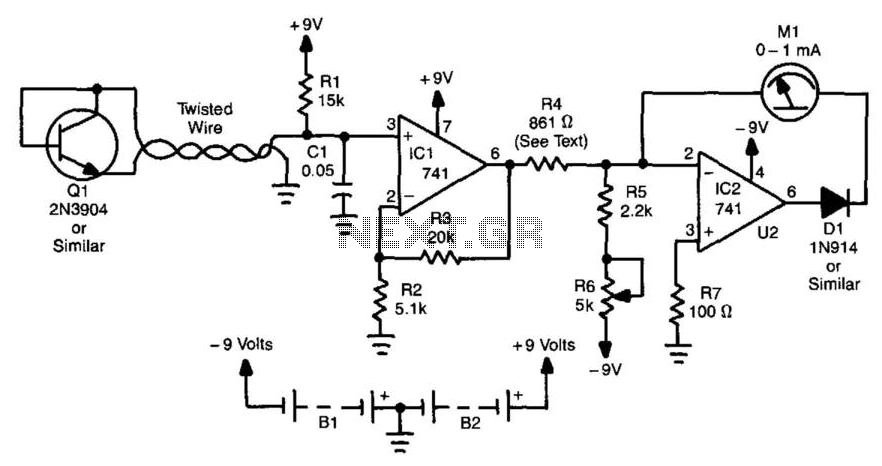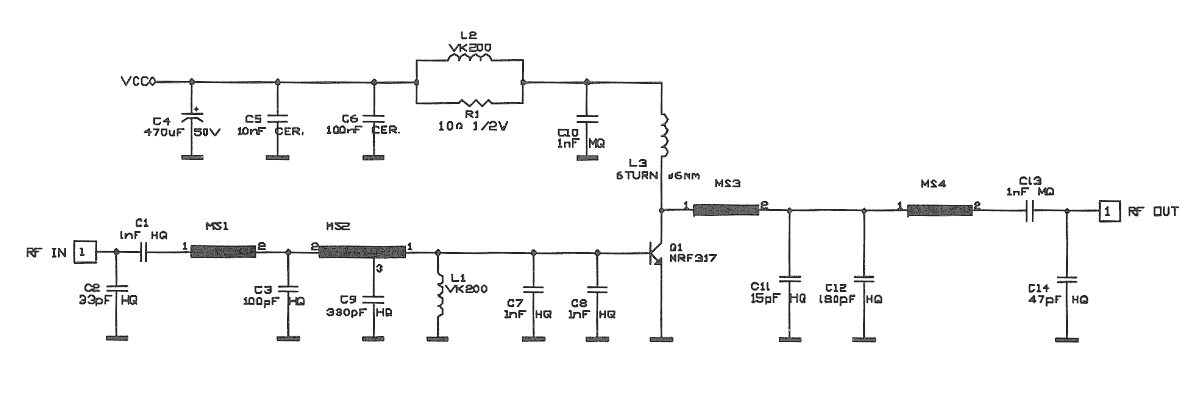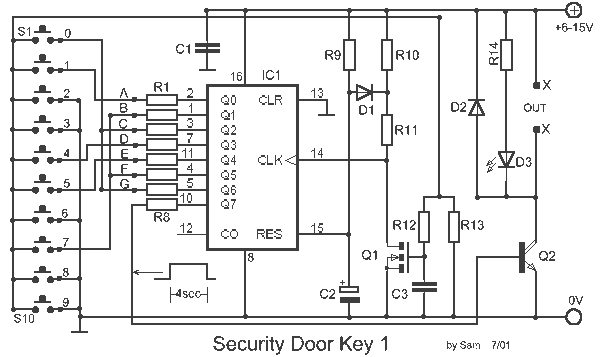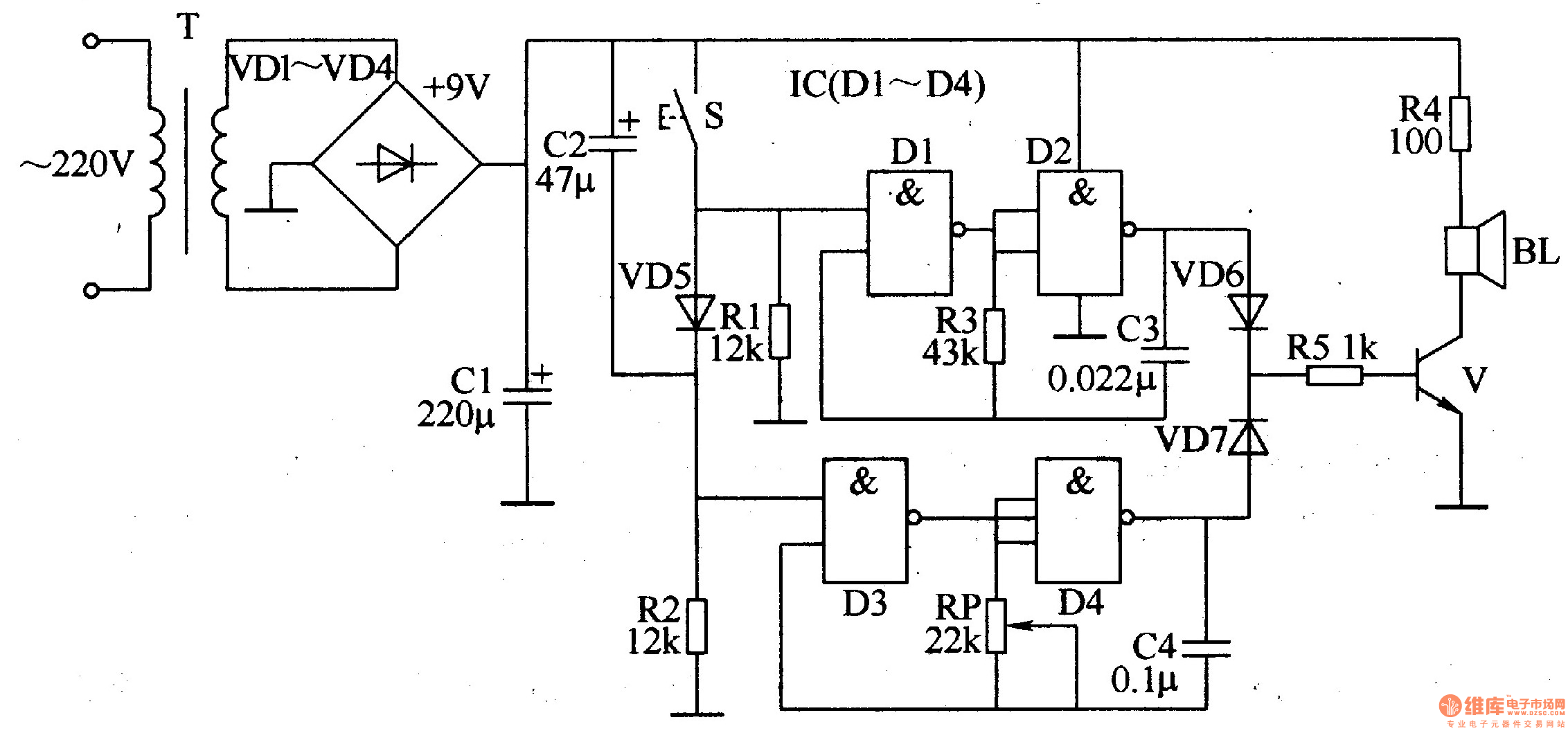
Electronic Thermometer

This thermometer is capable of measuring temperatures from -30 to +120 °F. A diode-connected 2N3904 transistor forms a voltage divider with R1. The transistor serves as the temperature sensor and should be connected to the rest of the circuit using twisted wire for optimal performance. As the temperature increases, the voltage drop across the transistor changes by approximately -1.166 mV/°F. Consequently, the current at pin 3 of IC1, a 741 operational amplifier with a gain of 5, decreases as the temperature measured by the sensor rises. A second 741 operational amplifier, IC2, is configured as an inverting amplifier. Resistors R5 and R6 are utilized to calibrate the current. At a temperature of around -30 °F, the current through R4 (created by connecting a 910-ohm and a 1600-ohm resistor in parallel) should equal the current through R5 and R6. A temperature of -30 °F will yield a meter reading of 0 mA, while a temperature of 120 °F will result in a meter reading of 1 mA. The scale between these points is divided into equal segments, marked with the corresponding temperatures. For example, dividing it into 150 equal segments means each division represents one degree. Calibration is performed by placing the sensor in an environment with a known temperature, such as an ice-point bath. The freezing point of water is approximately 32 °F. It is essential to verify the accuracy of this temperature using a reliable thermometer. The sensor is then placed in the bath, and R6 is adjusted until the correct meter reading is achieved.
The described thermometer circuit employs a diode-connected 2N3904 transistor as a temperature sensor, leveraging its characteristics to provide an analog voltage output that correlates with temperature changes. The transistor's behavior is critical; as temperature rises, the forward voltage drop across the diode-connected base-emitter junction decreases, resulting in a measurable change in output voltage. This voltage change is translated into a current change at pin 3 of the first operational amplifier (IC1), which operates with a gain of 5, amplifying the signal for further processing.
The second operational amplifier (IC2) is configured as an inverting amplifier, allowing for the manipulation of the output signal to correspond with the desired current output. The feedback resistors R5 and R6 play a crucial role in determining the gain and stability of this amplifier, ensuring the circuit operates within the expected parameters. The calibration process is essential for accuracy, as it aligns the output current with specific temperature readings. By adjusting R6 when the sensor is submerged in an ice-point bath, the circuit can be fine-tuned to ensure that the meter reflects the true temperature accurately.
The use of twisted wire connections minimizes noise and interference, which is vital in sensitive analog circuits, particularly those measuring small voltage changes. The arrangement of resistors R4, R5, and R6 ensures that the circuit maintains a balance between the measured current and the expected output, providing a linear response across the specified temperature range. The design's simplicity, combined with the operational amplifiers' versatility, allows for a reliable and effective temperature measurement solution suitable for various applications. This thermometer is capable of measuring temperatures from - 30 to +120 °F. A diode-connected 2N3904 transistor form s a voltage divider with Rl, The transistor is used as the temperature sensor and, for best results, it should be connected to the rest of the circuit with twisted wire, as shown. As temperature increases, the voltage drop across the transistor changes by approximately -1.166 mV/°F.
As a result, the current at pin 3 of IC1, a 741 op amp with a gain of 5, decreases as the temperature measured by the sensor increases. A second 741 op amp, IC2, is configured as an inverting amplifier. Resistors R5 and R6 are used to calibrate the current. At a temperature of about -30°F, the current through R4 (formed by connecting a 910- and a 1600- resistor in parallel) should equal the current through R5 and R6.
A temperature of - 30°F will result in a meter reading of 0 mA, while a temperature of 120 °F will result in a meter reading of 1 mA. Divide the scale between those points into equal segments and mark the divisions with the appropriate corresponding temperatures.
If you divide it into 150 equal segments, for instance, each division will equal one degree. Calibration is completed by placing the sensor in an environment with a known temperature, such as in an ice-point bath. The freezing point of water is approximately 32°F. Verify that the temperature is indeed 32°F using another thermometer that is known to be accurate. Then, simply place the sensor in the bath and adjust R6 until you get the correct meter reading.
The described thermometer circuit employs a diode-connected 2N3904 transistor as a temperature sensor, leveraging its characteristics to provide an analog voltage output that correlates with temperature changes. The transistor's behavior is critical; as temperature rises, the forward voltage drop across the diode-connected base-emitter junction decreases, resulting in a measurable change in output voltage. This voltage change is translated into a current change at pin 3 of the first operational amplifier (IC1), which operates with a gain of 5, amplifying the signal for further processing.
The second operational amplifier (IC2) is configured as an inverting amplifier, allowing for the manipulation of the output signal to correspond with the desired current output. The feedback resistors R5 and R6 play a crucial role in determining the gain and stability of this amplifier, ensuring the circuit operates within the expected parameters. The calibration process is essential for accuracy, as it aligns the output current with specific temperature readings. By adjusting R6 when the sensor is submerged in an ice-point bath, the circuit can be fine-tuned to ensure that the meter reflects the true temperature accurately.
The use of twisted wire connections minimizes noise and interference, which is vital in sensitive analog circuits, particularly those measuring small voltage changes. The arrangement of resistors R4, R5, and R6 ensures that the circuit maintains a balance between the measured current and the expected output, providing a linear response across the specified temperature range. The design's simplicity, combined with the operational amplifiers' versatility, allows for a reliable and effective temperature measurement solution suitable for various applications. This thermometer is capable of measuring temperatures from - 30 to +120 °F. A diode-connected 2N3904 transistor form s a voltage divider with Rl, The transistor is used as the temperature sensor and, for best results, it should be connected to the rest of the circuit with twisted wire, as shown. As temperature increases, the voltage drop across the transistor changes by approximately -1.166 mV/°F.
As a result, the current at pin 3 of IC1, a 741 op amp with a gain of 5, decreases as the temperature measured by the sensor increases. A second 741 op amp, IC2, is configured as an inverting amplifier. Resistors R5 and R6 are used to calibrate the current. At a temperature of about -30°F, the current through R4 (formed by connecting a 910- and a 1600- resistor in parallel) should equal the current through R5 and R6.
A temperature of - 30°F will result in a meter reading of 0 mA, while a temperature of 120 °F will result in a meter reading of 1 mA. Divide the scale between those points into equal segments and mark the divisions with the appropriate corresponding temperatures.
If you divide it into 150 equal segments, for instance, each division will equal one degree. Calibration is completed by placing the sensor in an environment with a known temperature, such as in an ice-point bath. The freezing point of water is approximately 32°F. Verify that the temperature is indeed 32°F using another thermometer that is known to be accurate. Then, simply place the sensor in the bath and adjust R6 until you get the correct meter reading.





